
The new aron kodesh (torah ark) at Moshav Nov, reviving artistic themes form ancient synsgogues in surrounding Golan Heights, Israel
In this essay I wish to share with you the process of designing and building the aron Kodesh for Moshav Nov in the Golan Height. Working on this piece, I was deeply inspired by the opportunity to draw upon artistic themes visible in nearby archaeological excavations of ancient synagogues, and weave these into my design for the new aron kodesh.
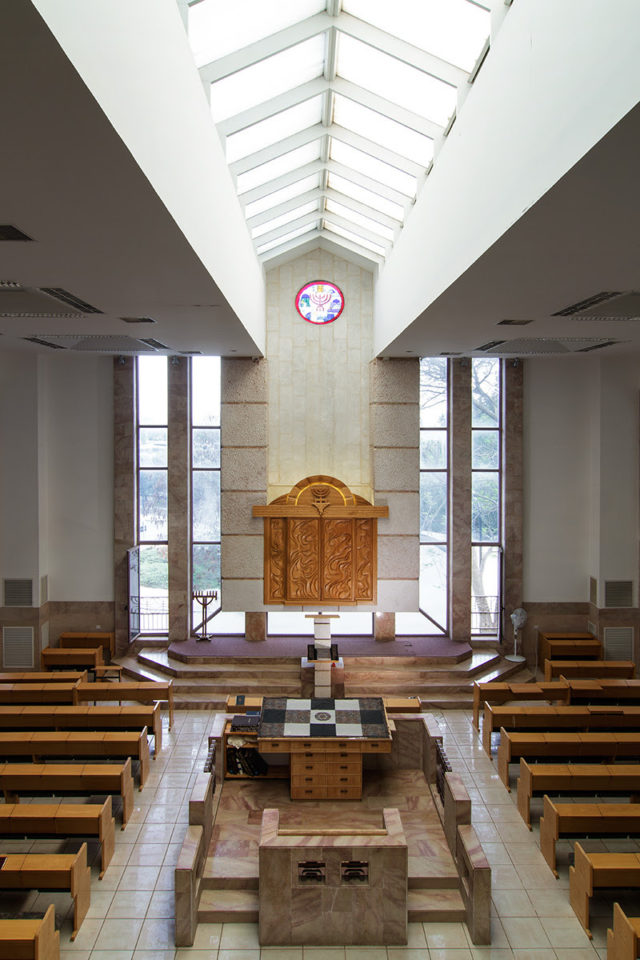
Aron kodesh in Moshav Nov – shown in context of the sanctuary
In the Byzantine era, during the fourth to seventh centuries c.e. the Jews built numerous synagogues in the Galilee and Golan regions of northern Israel. The remains of these synagogues can be visited today in archaeological sites throughout the area. One site of particular interest, known as Umm el Kanatir, (translated as “Mother of the Arches”), just a few kilometers from the modern Moshav Nov, is well known to the moshav members, who regard it as part of their heritage.
As background information for designing the Golan Renaissance aron kodesh, I received a guided tour of the ancient synagogue, now undergoing reconstruction in a state of the art, computer chip documented process. The unearthed remains reveal several unusual and intriguing examples of stone carving, among which both the menorah and the grape vine can be seen around the raised dais of the ancient aron kodesh. It is noteworthy that all the stone in the region is the black basalt, a volcanic rock that would have made the carving of those details extremely difficult with the tools available in the Byzantine period.
My goal in designing synagogue furniture is to touch the congregants deeply and enrich their synagogue experience. Noting the sense of connection that the modern residents of Nov feel towards the ancient synagogue, I decided to incorporate modern interpretations of some of its symbols in the design for the new aron kodesh. For instance, at the top of the aron kodesh I placed a wooden representation of the stone menorah with its tripartite support.

Carved stone menorah, ancient synagogue of Umm el Kanatir
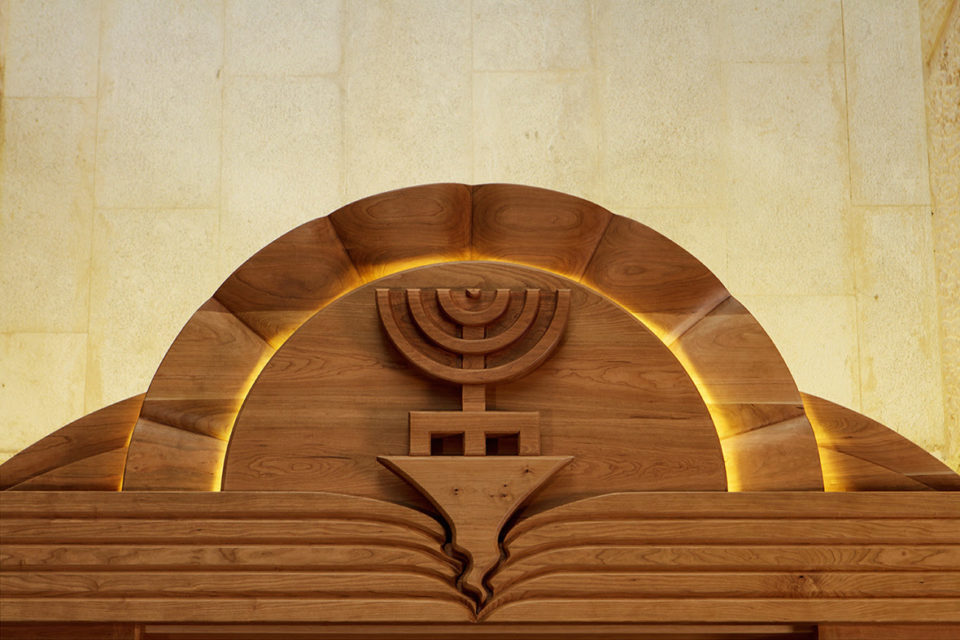
Carved menorah in top section of aron kodesh, Moshav Nov
I also wanted to celebrate the ancient Golan tradition of wine culture, as represented in the carved stone grape vines of the ancient Umm el Kanatir synagogue, and continuing with today’s internationally acclaimed Golan vineyards. Aside from its refined taste, wine plays a central role in many Jewish rituals and holidays. I chose to hand-carve my own version of grape vines on the fixed panels on either side of the aron kodesh.

Carved stone grape vines in the ancient Umm el Kanatir synagogue

Hand-carved grape vines on fixed side panels of aron kodesh, Moshav Nov
I included another element in the Nov aron kodesh to resonate with the ancient synagogues of the Golan. A hallmark of these ancient structures was the massive stone beam spanning the entrance to the sanctuary.
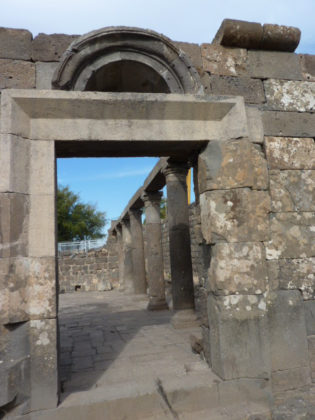
Stone beam and arch spanning entrance to the ancient Umm el Kanatir synagogue
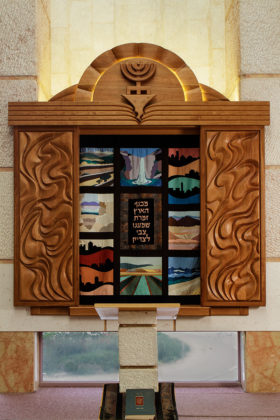
Front view of Golan Renaissance aron kodesh, showing the wood beam and arch on top, and the parochet revealed by sliding both doors to the sides.
As seen in the above photo, the cross beam is bisected by an organic form upon which the menorah rests. This form represents a cornucopia, signifying the fertility of the land. The cross beam is deeply grooved, representing the many deeply cut ravines in the Golan’s plateau. Finally, the cross beam fanning out from the center alludes to the cherubs’ wings spread over the ark of the covenant, as described in the Torah.
I hope I’ve been able to show in this essay how custom furniture can serve functional art and touch people on the emotional level. In the case of Nov aron kodesh, it was also an opportunity to revive ancient Jewish themes.
Below are several additional photos showing the work on the Nov aron kodesh in progress.

With moshav member Ilit Eitam, at the foot of the reconstructed aron kodesh, ancient synagogue Umm el Kanatir
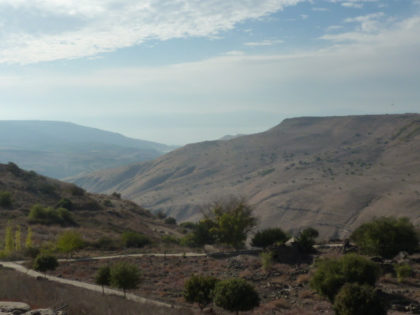
View from ancient synagogue of Umm el Kanatir, showing Golan plateau and typical ravines

Working on the final drawing for the aron kodesh
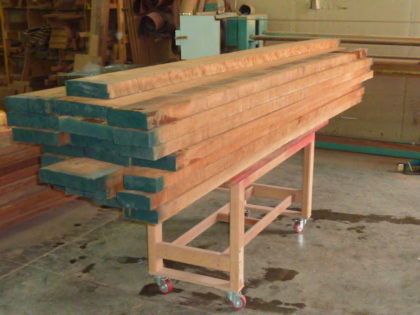
The lumber arrives at my workshop, solid 2″ thick cherry planks
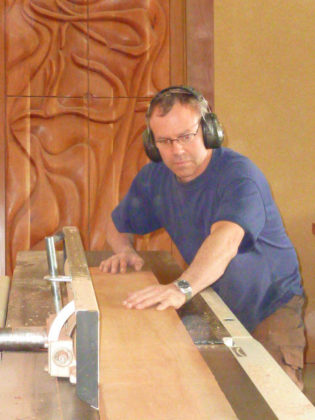
Jointing and planning the cherry boards for the aron kodesh
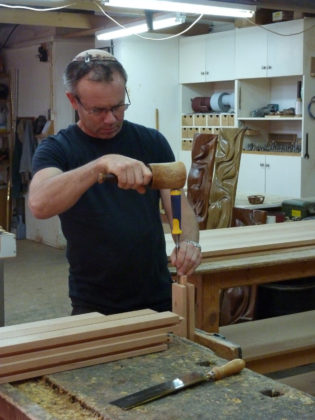
Fitting the mortise and tenon joints that hold the frames together

Initial stage in sculpting the panels for the aron kodesh
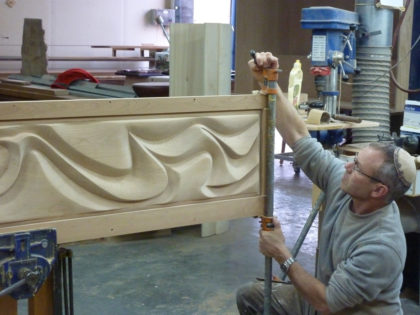
Gluing up the sculpted panels inside the frames

Hand-carving the grape vines on the side panels of the aron kodesh
